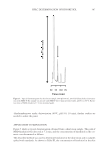PHYSICOCHEMICAL PROPERTIES OF DELIPIDIZED HAIR 369 characteristics of a surface. Delipidized hair yields lower kb and higher ka values than virgin hair indicating that its surface is more acidic (less basic) due to the removal of lipids. It is possible that once free lipids are removed from the surface, pendant groups on amino acids of upper layer cuticular structural proteins are exposed rendering the hair surface more acidic. Extrapolated total surface energy distributions obtained from iGC SEA provide a repre- sentative illustration of changes in the surface chemistry of hair that occur as a result of delipidization. Figure 9 contains profi les for both hair types tested. The data were fi tted to an empirical function and converted into a normalized distribution to display the sur- face energy results in a more illustrative manner. This total surface energy distribution estimates the percentage of both dispersive and acid–base sites at a particular surface en- ergy. Interestingly, virgin hair has a much broader distribution, indicative of its very heterogenous surface characteristics. In contrast, delipidized hair has a very sharp total surface energy distribution as a result of its more homogenous surface. CONCLUDING REMARKS In the last several decades, we have witnessed studies searching for the importance of covalently attached 18-MEA in determining the surface properties of hair (2–4). Herein, we provide evidence that supports an indispensable role of noncovalently bound lipids in Figure 9. Total surface energy distributions of virgin and delipidized hair obtained by iGC SEA. The units are percentage of covered surface (where the total surface covered is determined by BET) vs extrapolated total surface energy (mJ/m2).
JOURNAL OF COSMETIC SCIENCE 370 the surface properties of human hair. Moreover, we show the importance of noncovalently bound lipids not only in governing the properties of hair, but also how they infl uence treatment with hair care products. In closing, the delipidization of hair represents a situ- ation many consumers fi nd themselves in after undergoing a harsh cosmetic procedure, or due to natural or environmental aging of the mature hair shaft. ACKOWLEDGMENTS We express our sincere gratitude to Dr. Dan Burnett from Surface Measurements Sys- tems, Ltd., for his contribution of the section involving iGC SEA. REFERENCES (1) C. R. Robbins, The cell membrane complex: Three related but different cellular cohesion components of mammalian hair fi bers, J. Cosmet. Sci., 60, 437–465 (2009). (2) L. N. Jones and D. E. Rivett, 18-Methyleicosanoic acid in the structure and formation of mammalian hair fi bres, Micron, 28, 469–485 (1997). (3) L. Coderch, S. Méndez, C. Barba, R. Pons, M. Martí, and J. L. Parra, Lamellar rearrangement of internal lipids from human hair, Chem. Phys. Lipids, 155, 1–6 (2008). (4) J. Smith and J. Swift, Maple syrup urine disease hair reveals the importance of 18-methyleicosanoic acid in cuticular delamination, Micron, 36, 261–266 (2005). (5) P. W. Wertz and D. T. Downing, Integral lipids of mammalian hair, Comp. Biochem. Physiol., 92B, 759–761 (1989). (6) G. Zhang, L. Senak, and D. J. Moore, Measuring changes in chemistry, composition, and molecular structure within hair fi bers by infrared and Raman spectroscopic imaging, J. Biomed. Opt., 16(5), 056009 (2011). (7) J. Jachowicz and R. McMullen, Mechanical analysis of elasticity and fl exibility of virgin and polymer- treated hair fi ber assemblies, J. Cosmet. Sci., 53, 345–361 (2002). (8) J. Jachowicz, Fingerprinting of cosmetic formulations by dynamic electrokinetic and permeability anal- ysis, II. Hair conditioners, J. Soc. Cosmet. Chem., 46, 100–116 (1995). (9) R. A. Lodge and B. Bhushan, Wetting properties of human hair by means of dynamic contact angle measurement, J. Appl. Poly. Sci., 102, 5255–5265 (2006). (10) R. McMullen and S. P. Kelty, Investigation of human hair fi bers using lateral force microscopy, Scanning, 23, 337–345 (2001). (11) F.-J. Wortmann, A. Hullmann, and C. Popescu, Water management of human hair, IFSCC Mag., 10(4), 317–320 (2007).
Purchased for the exclusive use of nofirst nolast (unknown) From: SCC Media Library & Resource Center (library.scconline.org)





















































































